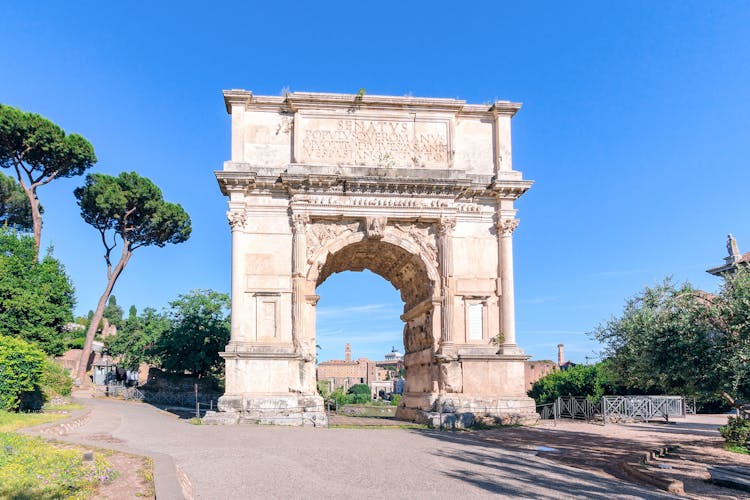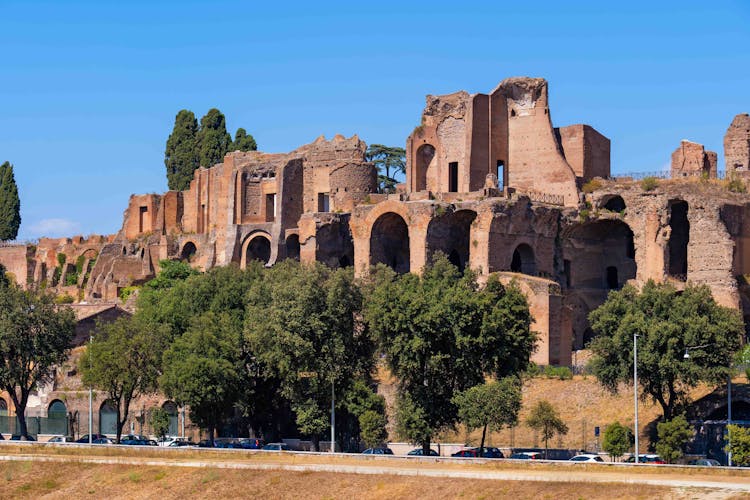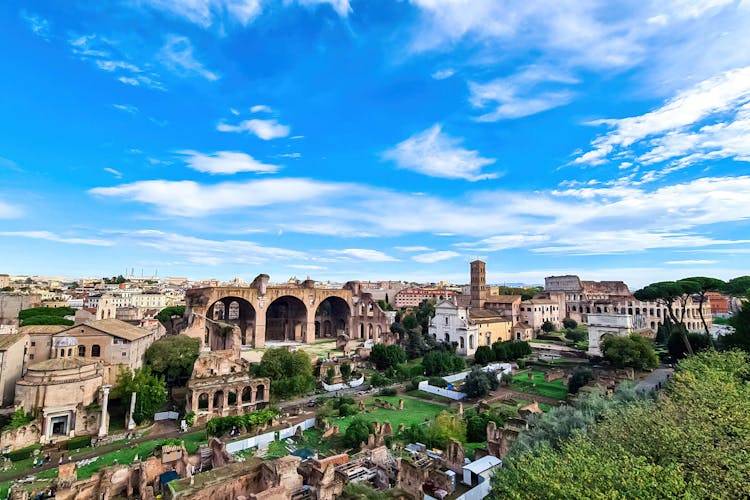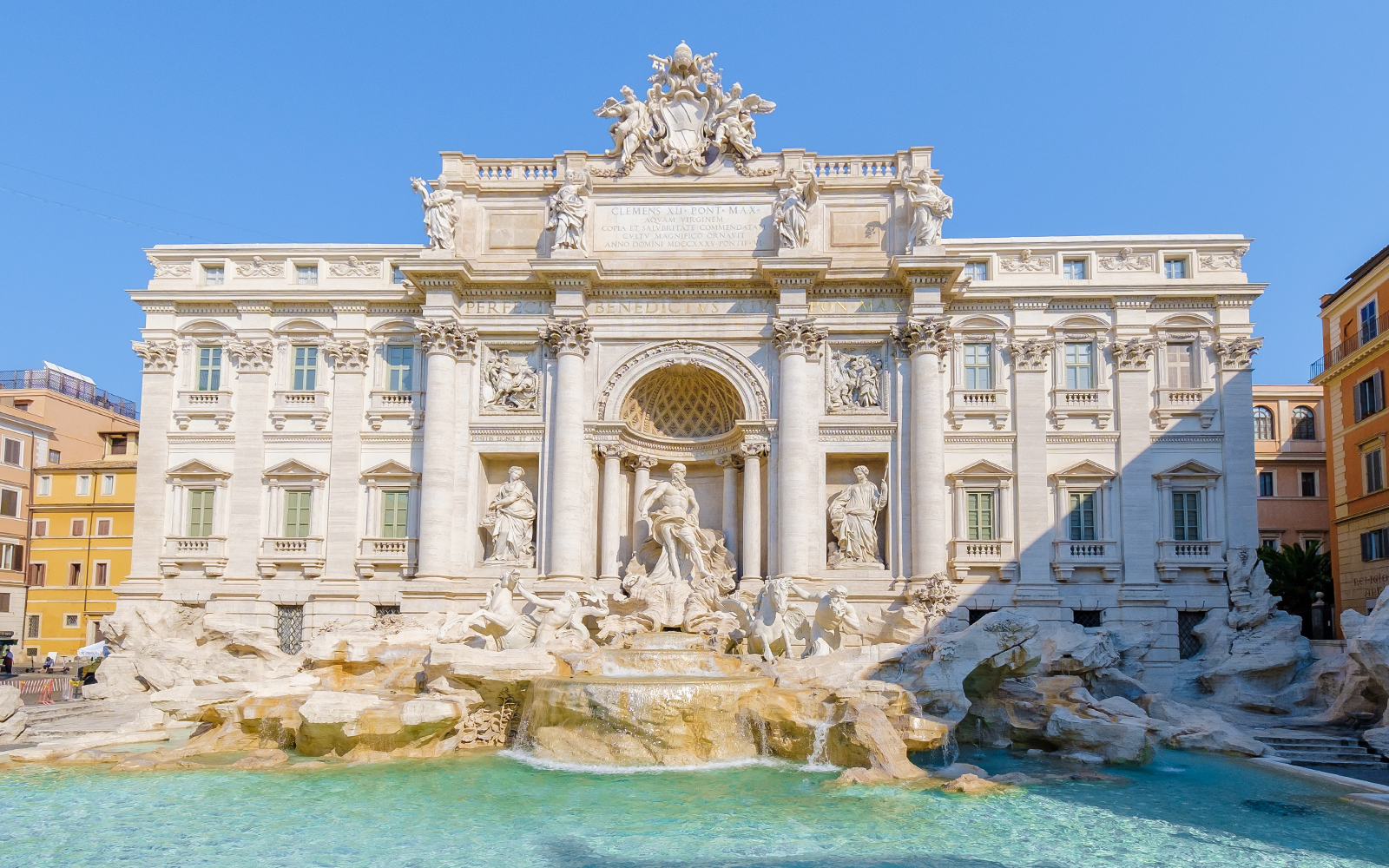The Palatine Hill has long been a part of Rome's history and is known for its incredible archaeological discoveries. The hill is located near the Roman Forum and overlooks the Circus Maximus. Palatine Hill is believed to have been the site of the earliest settlements in Rome and later became the residence of the Roman emperors. Palatine Hill is a significant part of the main archaeological area of ancient Rome and is sitting next to the Colosseum and the Roman Forum.

Know Before You Go
Handy information
| ⏰ Suggested Duration: | 2-3 hours |
| ☀️ Best Time to Visit: | Early morning or late afternoon |
| 🎟️ Priority Access to Colosseum + the Palatine Hill: | €19 |
| 😍 Special Access Tour of the Colosseum + the Palatine Hill: | €54 |
Must See
- Flavian Palace
- Stadium of Domitian
- Hut of Romulus
- House of Augustus
- House of Livia
Things To Know
Also called: The first nucleus of the Roman Empire
Location: Rome
Rulers: Domitian, Augustus, Cicero
First Excavation: 1907
Opening Hours And Address
Monday to Sunday: 09:00 AM to 04:30 PM
It may be open until 07:00 PM depending on the season
Closed on 25 December and 1 January
Address:
00186 Rome, Metropolitan City of Rome Capital, Italy
Get Directions
Why Visit Palatine Hill?
- Historical significance: Palantine Hill is one of the Seven Hills of Rome and is considered the birthplace of the city. It is rich in history and archaeological wonders.
- Panoramic views: From the top of Palantine Hill, you can enjoy breathtaking views of the Roman Forum, Colosseum, and other ancient landmarks.
- Ruins and gardens: Explore the ancient ruins of imperial palaces and villas that once stood on Palantine Hill. You can also wander through the tranquil gardens and admire the beautiful flora.
- Mythology and legends: Palantine Hill is associated with several fascinating myths and legends from Roman mythology, adding an extra layer of intrigue to your visit.
- Walking and hiking: Enjoy a leisurely stroll or embark on a hike through the pathways and trails that crisscross Palantine Hill.
Palatine Hill Recommended Tickets
History Of Palatine Hill
Palatine Hill has played a pivotal role in foundation of ancient Rome. In Roman mythology, this hill is believed to be the site where the legendary brothers Romulus and Remus - sons of Mars and Rhea Silvia - were discovered by the she-wolf that raised them. It is also said that Romulus & Remus went on to found Rome upon this very hill after a conflict with this brother ( Remus wanted to found the city on Aventine Hill ). This story has come to symbolize the founding of Rome, and it remains an important part of its history and culture.
Today, Palatine Hill is home to some of the most important archaeological sites in Rome, including remains of imperial palaces and temples. Its importance in Roman history makes it a popular destination for tourists and historians alike, as they explore the ruins that remain from ancient Rome. The Palatine Hill stands as a reminder of the city's storied past, and its significance will continue to be celebrated for years to come.
What to See at the Palatine Hill
1Palace of Emperor Augustus
The Palace of Emperor Augustus is symbolic of an important transition in Roman history when the Palatine transformed itself from a residential plateau into the seat of imperial power. All the wall paintings and mosaics illuminate the life of the emperor and give insight into the contemporary Roman world.

2Arch of Titus
Built soon after the death of Emperor Titus Flavius, the Arch of Titus commemorates the Roman triumph, given to Emperor Vespasian and to Titus, his son, and heir for the victory in the Jewish war. The arch consists of panels that depict the triumphal procession that was celebrated in 71 AD after the Roman victory and provides one of the few contemporary depictions of artefacts of Herod’s Temple.

3Temple of Apollo
The Temple of Apollo was built at the height of Greek civilization in the second half of the 5th century BC and was dedicated to Apollo Epicurius by the Phigaleians. The temple occupied the most important and prominent position in the Delphic Panhellenic Sanctuary.

4House of Livia
Augustus and his wife Livia had houses beside one another on the Palatine. Both the houses were elaborately decorated with frescoes and mosaics and many of which remain. In the House of Augustus, you can spot the emperor’s private study where he wrote his autobiography, The Deeds of the Divine Augustus.

5The Lupercal Cave
The Lupercal was a cave situated at the southwest foot of the Palatine Hill, located between the temple of Magna Mater and the Sant’Anastasia al Palatino. While discovering Rome, Romulus and Remus were found there by the she-wolf who took them till they were rescued by the shepherd Faustulus. Luperci, the priests of Faunus, celebrated various ceremonies of the Lupercalia at the cave, from the earliest days of the city till 494 AD.

Palantine Hill Opening Hours
The Roman Forum and Palatine Hill are open year round. The gates are open from 08:30 AM until an hour before sunset.
Getting There
The Palatine Hill can be reached from the Roman Forum by taking a left after the Arch of Titus, once you have entered the Forum from the Colosseum side. If you have entered the Forum from Via dei Fori Imperiali, you will see the Palatine large over the Forum, beyond the House of the Vestals.
The best place to enter the Palatine is from Via di San Gregorio, situated just behind the Colosseum. The advantage of this entrance is that there are fewer steps to climb.
If you are opting for public transportation, the closest Metro stop is Colosseum on the B Line. The 75 bus runs from Termini Station and stops next to the Via di San Gregorio entrance. Trams 3 and 8 stop on the east end of the Colosseum and are a short walk to the Palatine entrance.
Palatine Hill Facts
- Palatine Hill is a four-sided plateau, rising 131 feet south of the Forum in Rome and 168 feet above sea level. It has a circumference of 5,700 feet.
- Emperor Domitian, from the Flavian Dynasty, built one of the largest palatial complexes on Palatine Hill.
- As per Roman mythology, the Palatine Hill was a location of the cave, known as Lupercal, where Romulus and Remus were found by a she-wolf Lupa that kept them alive.
- Founded in the 2nd half of the 19th century, the Antiquarium exhibits fragments of frescoes, sculptures, and archaeological material found on the hill. The Palatine Museum is situated in the former Monastery of the Visitation, built on the remains of Domitian’s palace.
Insider Tips For Visiting Palantine Hill
- Carry sunscreen & a waterbottle if you're travelling to Rome in the summer months; it gets hot!
- Book your tickets to the destination online to move faster through the queues.
- From atop the Palatine Hill, you'll get the best view of .
- The entire complex is free for visitors on the first Sunday of the month; it will be crowded though!
- Make sure you wear good walking shoes as the pathways to cement sidewalks and the roads tend to be uneven.
- Pack some snacks! There aren't a lot of shops or restaurants inside the historical complex.
Restaurants Nearby

The Unique Al Palatino Garden Restaurant is a hidden gem near Palatine Hill. Nestled amidst lush greenery, this charming restaurant offers a delightful dining experience. With its tranquil atmosphere and picturesque surroundings, it provides the perfect setting to enjoy a delicious meal.
Distance from Palantine Hill: 1 KM

Angelino "ai Fori" dal 1947 is a popular restaurant near Palatine Hill. From traditional pasta dishes to mouthwatering pizzas, Angelino "ai Fori" dal 1947 is a must-visit for food enthusiasts looking to savor authentic Roman flavors.
Distance from Palantine Hill: 50 meters

Delizie e Sapori is a renowned restaurant located in the heart of Rome, near Palantine Hill. With its exquisite combination of sea and land specialties, it offers a culinary experience that captures the flavors of the Roman tradition.
Distance from Palantine Hill: 220 meters

This restaurant offers an authentic Italian dining experience with a cozy atmosphere and friendly staff. Serving a variety of traditional dishes made with fresh, locally sourced ingredients, the restaurant is known for its delicious pasta, seafood, and decadent desserts.
Distance from Palantine Hill: 190 meters
Attractions Near The Palantine Hill
Hotels Near Palantine Hill
FAQs
The Palatine Hill is known as the birthplace of ancient Rome and is said to have been inhabited since 1000 B.C. Roman citizens during the Republican era belonging to the upper class had settled in the Palatine Hill and built sumptuous palaces.
The Palatine Hill is situated 40 metres above the Roman Forum and is the most central of the seven hills of Rome, forming one of the oldest regions of the city.
Since the beginning of the Empire (27 BC) Augustus had built his palace and the hill gradually became the exclusive domain of emperors.
During the Middle Ages, a lot of churches and convents were built on the hill, and in the Renaissance and the Farnese family had used portions of the Palatine for their private botanical gardens. After their era, the Palatine was left untouched, until it was opened to the public as an archaeological site.
A lot of ruins can be discovered on Palatine Hill, including the Stadium of Domitian and the Flavian Palace.
Today, the Palatine Hill is a great archaeological site, where you can discover the ruins of the Flavian Palace as well as the Stadium of Domitian, along with the legendary Hut of Romulus.
Yes, guided tours of the Palatine Hill are available. There isn’t much information on display around the attraction, and visitors tend to wander around. By going on a guided tour, you can make the most of your visit as you will get an insight into the history and architecture of the place.







